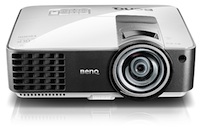BenQ Rolls Out Short-Throw Projectors, Interactive Wall Displays

The BenQ MW820ST features WXGA resolution and a lamp life of up to 10,000 hours. |
BenQ is expanding its lineup of energy-efficient short-throw projectors. The company has also debuted new interactive wall displays and an enhanced version of its "SmartEco" technology this week at the InfoComm 2013 conference taking place in Orlando, FL.
The new short-throw projectors include the MX819ST and MW820ST, both single-chip DLP projectors offering a contrast ratio of 13,000:1 and a light output of 3,000 lumens. The MX819ST is an XGA-resolution projector (1,024 x 768), while the MW820ST offers WXGA resolution (1,280 x 800).
The MX819ST has a throw ratio of 0.61, allowing it to project a 78-inch image form a distance of 38 inches. The MW820ST, meanwhile, has a throw ratio of 0.49 and can project an 80-inch image from just 36 inches.
Other features common to both new projectors include:
- 10,000-hour lamp life using the new SmartEco technology, which dynamically adjusts the lamps power between 80 percent and 30 percent;
- Eco Blank mode for blanking the screen when it's not in use, saving more power;
- A "no source detected" mode, which reduces power after a source has not been detected for three minutes;
- Dynamic lamp adjustment (separate from the SmartEco adjustment) that dynamically changes lap power based on ambient light;
- ±30 degree vertical keystone correction;
- LAN control;
- 10 watt speaker;
- Support for Crestron, PJLink, RoomView, eControl, and AMX systems; and
- Security features, such as a security bar.
AV inputs include HDMI, dual RGB (mini D-sub 15-pin), S-video, composite video, RCA audio, and stereo minijack. AV outputs include RGB and stereo minijack. Networking and control ports include LAN (RJ-45), USB type mini B, and RS-232.
The MX819ST and MW820ST are both available now. The MX819ST sells for $1,099; the MW820ST sells for $1,299.
BenQ said its enhanced SmartEco technology will now be incorporated across all of its product lines.
BenQ also debuted several interactive wall displays at the InfoComm conference, including its new P Series of Super Narrow Bezel displays (featuring a gap of 3.5 mm top and left and 2.1 mm bottom and right) for up to 10 x 10 wall displays; the the Interactive Touch IL Series of interactive displays, which offer up to six-point multitouch capabilities; and Mainstream SL Series digital signage for high-traffic public areas.
Further details about all the new technologies can be found on BenQ's site.